The Little City’s Big Sewage Challenge – Part 1
Summary
Development underway and planned throughout the City prompts the need for greater sewage capacity and a demand from Fairfax County that Falls Church more aggressively manage peak flows of stormwater into the sewage system, resulting in an immediate cost to the City of nearly $20 million. How this significant expense will be financed has yet to be determined and could impact the tax rate.
In addition, though the Quinn Homestretch project sits in the part of the sewer shed that flows to Fairfax County, City staff recommends that, if approved, this development’s wastewater be pumped to Arlington County where additional capacity exists.
It seems that the City’s current development projects – let alone any future development – cannot go forward without Fairfax’s agreement to increase capacity and Arlington’s acceptance of new flows from other parts of the City.
The Sewage Challenge
Falls Church has an immediate sanitary sewage problem, is reliant on neighboring jurisdictions to address it, and faces an even greater challenge in how to cover the cost of solving it.
In the first of two briefings, City Manager Wyatt Shields and staff told City Council the City should expect to spend nearly $20 million by 2025 for additional sewage capacity to support development currently underway and new infrastructure in the form of an underground basin or vault designed to manage sewage flows to enable future capacity purchases and continued City growth.
Speaking at the Council’s February 5, 2024, work session, Mr. Shields and Public Works Director Zak Bradley began to define the issues surrounding purchase of additional sewage capacity from Fairfax County, which along with Arlington County processes the City’s wastewater. They addressed Fairfax’s requirement since May 2023 that the City more aggressively manage peak flows during high rain events, which they attributed to older single-family homes directly connecting stormwater runoff to the sewer system, and outlined the staff’s proposed solutions to meet current and future needs.
Mr. Shields and Mr. Bradley were accompanied by Andy Young, Interim Deputy City Manager for External Operations, and Alan R. Dalton, P.E., City Engineer, who analyzed the City’s technical options to address the increase in sewage flows.
More than a straightforward sewage capacity issue
“On one hand, this is a very straightforward sewage capacity purchase agreement,” Mr. Shields said, noting that the City has been in discussions with Fairfax for the past five years about purchasing additional capacity, especially given increased development in the Tripps Run sewer shed that flows to the County. Developments constructed in this sewer shed include West Falls, Founders Row I and II, new commercial projects, and future construction in the T-Zones as well as the proposed Quinn Homestretch project.
However, Mr. Shields added, “Right now, we have a financing problem,” and one that staff was not ready in early February to propose how to tackle. “Purchasing capacity is expensive, and the peak flow management [of the infiltration and inflow of stormwater to the sewer system] adds to that,” he said, emphasizing later in the meeting that, “I do want Council to be aware that the financing of this will be difficult.” Mr. Shields promised that the staff would come back to the Council on March 4, 2024, with detailed plans for handling peak flows and financing proposed capacity solutions.
Understanding the Falls Church sewage system
In his briefing for City Council, Mr. Bradley explained that the City currently relies on the sewer systems of its two neighboring jurisdictions to process wastewater. The map below shows the division of the City’s system between two sewer sheds – Four Mile Run, which flows to Arlington (shown in green), and Tripps Run, which flows to Fairfax (shown in yellow).
Tripps Run receives sewage flows from three sub-sheds not shown on the map:
- Tinner Hill, which contributes about 15% of the total sewage flow and presents few problems to the system;
- Cedar Lane, which accounts for 5% of the total flow and where the City has worked to reline 95% of the pipes and maintenance holes to minimize infiltration of stormwater into the sewer system and where two-thirds of this sub-shed’s users live in Fairfax; and
- Sisler, which comprises 80% of the total flow and the bulk of the new development that must be accommodated.

The need for more capacity from Fairfax
While the capacity of 0.8 million gallons per day (MGD) through its agreement with Arlington is presently underutilized, Falls Church already exceeds the 1.0 MGD allotted the City by Fairfax under an existing agreement by about 0.02 MGD, Mr. Bradley said.
The City is negotiating with Fairfax County to purchase an additional 0.5 million gallons per day of sewer flow capacity, which is projected to cost Falls Church about $9.3 million to cover flows from the new developments. This would meet the City’s wastewater conveyance needs through next year, Mr. Bradley said. Meantime, approved site plans for Founders Row I and II provide flow rate estimates and indicate they are well within capacity, though information provided to City Council on February 5 shows these developments appear not to be fully within capacity without this purchase.
Further, Mr. Bradley added, Fairfax County is insisting that if it sells the City this capacity, Falls Church must ensure that its peak flow surges do not exceed the total negotiated capacity of 1.5 MGD, or the City will face severe fines and may be barred from purchasing an additional 0.25 MGD capacity that will needed by 2028 to support later phases of the West Falls and any other development. To better manage peak flows, Mr. Bradley said the City proposes building a large sewage storage vault, or “flow equalization basin,” under Cavalier Trail Park’s tennis courts at a cost of $10 million.

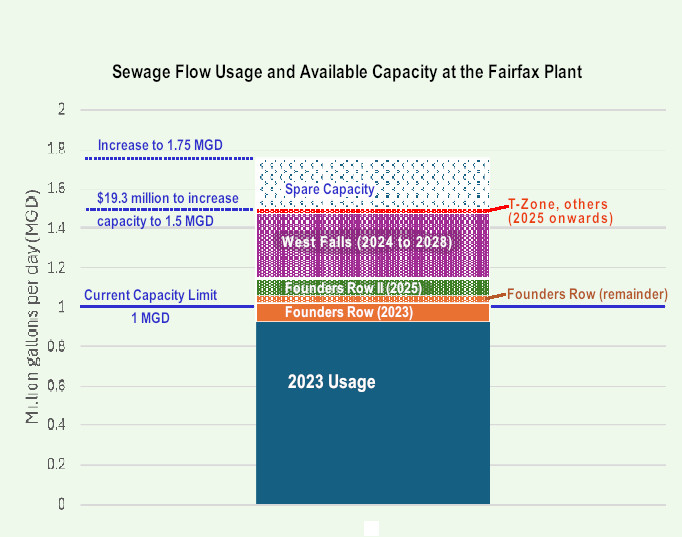
Building a basin to manage peak flows
Mr. Bradley explained that peak flows are caused by infiltration (seepage into sewer pipes through holes, cracks, joint failures, and faulty sewer pipe connections) and inflow (stormwater from roof drain downspouts, foundation drains, sump pumps, storm drain cross-connections, and holes in maintenance hole covers). If unmanaged, peak flows threaten to overwhelm downstream pipes and backflow into houses.
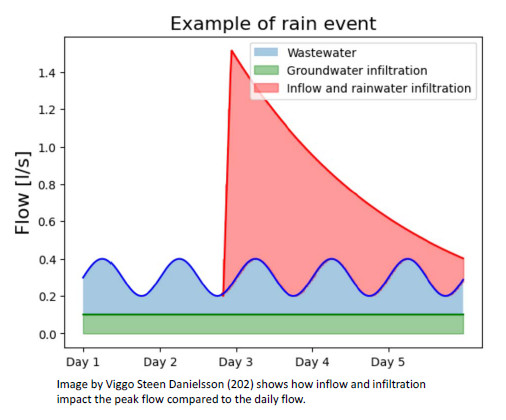
During major storm events, sewage from the Sisler sub-shed would collect in the proposed flow equalization basin and be slowly released to the Fairfax County system to prevent peak surges and any financial or future purchase penalties such flows would trigger. With a capacity of 750,000 gallons, the structure would be the size of the tennis courts and would be buried eight feet beneath them, Mr. Dalton said. The basin could accommodate a 200-year storm of the intensity and duration that Falls Church saw in July 2019, added Mr. Bradley.

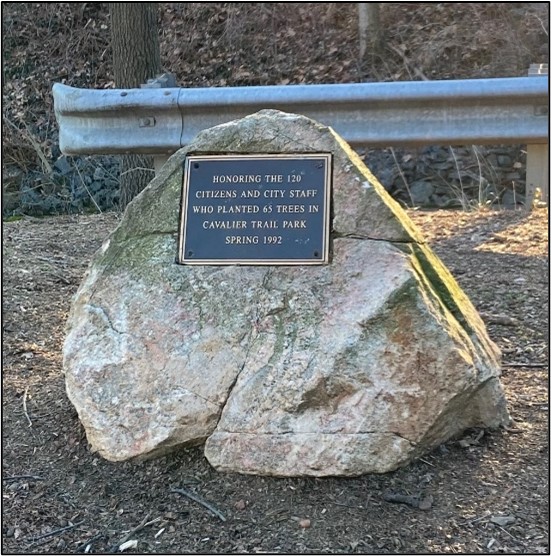
Entrance to and views of Cavalier Trail Park tennis courts and plaque honoring 120 citizens and City staff members who planted 65 trees in the park in 1992. The impact of the flow equalization basin construction on the trees surrounding the tennis courts has yet to be discussed. Falls Church Pulse photos.
Mr. Bradley and Mr. Shields asserted that most of the City’s infiltration and inflow (I & I) prompting Fairfax’s new requirement and the need to construct the basin is a “legacy” issue due to older homes’ drainpipes or sump pumps connected directly into the sewer lines. These connections sharply increase flows during heavy storms, overwhelming the sewer system, they said. Newer development projects and homes are required to retain this stormwater on site for slow release into the separate stormwater system. Fairfax is reviewing its own “legacy” stormwater issues to keep its total needs in check, Mr. Bradley said.
Alternatives discussed, including efforts to disconnect older homes’ stormwater runoff from sewer lines?
The City does not know how many Falls Church homes are sending stormwater runoff into the sewer lines, according to City staff. Further, there is no program in place to require or otherwise incentivize homeowners to disconnect their older residences from the sewer system.
The Falls Church Pulse has asked City staff if such a program might be put in place, how its cost/benefit compares to the recommended basin, and whether technical solutions other than the $10 million vault were considered. The staff’s responses will be published as soon as the Pulse receives them. Mr. Shields said sewer access fees charged by the City will pay some of the $19.3 million in expected financing needs – but “will not come close to covering all of it.” The staff plans to provide further detail on how the balance might be financed at the Council’s March 4 meeting.
A Quinn Homestretch project workaround
Mr. Bradley noted that the Quinn Homestretch project will generate 0.07 MGD in sewage that could flow to Arlington rather than Fairfax via a public force main pump system that would be built by the developer and covered by the sewer availability fees the developer would otherwise pay the City. Those fees are $7,088 per apartment for the project’s 233 apartments, or a total of $1,651,504. If the cost of the force main pump is greater, Quinn would be responsible for it, according to Mr. Shields.
Mr. Bradley said this possible workaround of the City’s capacity issues with Fairfax is still being negotiated with Arlington and requires changing the boundaries within Falls Church for the flows Arlington will accept. If Arlington approves, the City staff recommends that this option be adopted.
If the Quinn project is approved and pipes its wastewater to Arlington, then current and anticipated sewage flows to that County would be as follows:
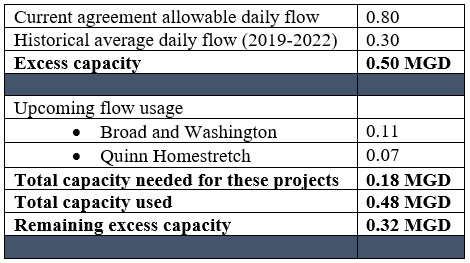
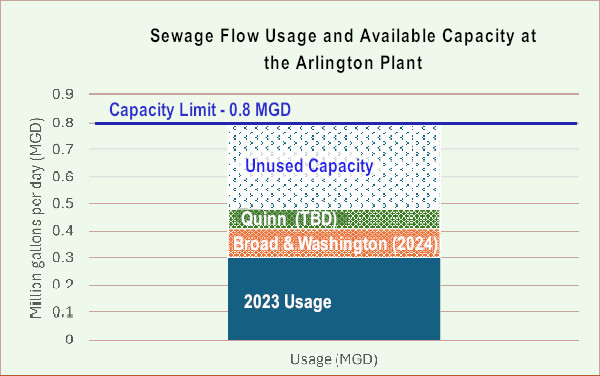
Flows from the Quinn Homestretch project to Fairfax are the fallback if Arlington does not agree to the boundary change, however, and would likely displace the flows from phases 1b and 2 of the West Falls project expected to be completed in 2028.
Accommodating future projects along South Maple Avenue
If constructed, the Quinn force main pump system would be housed on its project land, and could become the backbone for use by additional future projects along Maple Avenue, including a prospective 7-story project at the corner of South Maple and West Annandale Road behind Burke & Herbert Bank and beside Harris Teeter as well as a potential revamp of the One City Center project at Broad and Washington Streets and a possible 6-story Virginia Village development. Each of these projects would tie its own private pump into the Quinn’s force main pump. If these three projects follow the precedent of Founders Row II and Broad and Washington flows, they would virtually use up the remaining capacity flow to Arlington.
Because the Quinn sewer fees would cover the new force main system to Arlington, there would be no impact on other City benefits included in the Quinn project’s voluntary concessions, Mr. Shields said. The Quinn Homestretch project is expected to be up for final Council approval on February 26, 2024.
Data requested on the increase in sewer flows between 2014 and 2023
Council member David Snyder asked for data on the increase in sewer flows between 2014 (the earliest available data from Fairfax County, according to City staff) and 2023 to help determine how much of the new flows is caused by mixed-use development projects. Mr. Snyder said he wants to ensure that new capacity needs are thoroughly considered in assessing the infrastructure costs of future projects. “Should we be more aggressive in what we require of new development?” he asked.
Mr. Bradley promised to have that data available for the second briefing on the sewer issues during the Council’s March 4 meeting. Stay tuned for Part 2 on this issue following that meeting.

References
- City Council Work Session, February 5, 2024, Sanitary Sewer Capacity Purchase Briefing #1. This video will not display properly on a small screen as it includes the meeting agenda.
- City Council Work Session, February 5, 2024, Sanitary Sewer Capacity Purchase Briefing #1, YouTube video of the Council Work Session.
- Sanitary Sewer Capacity Presentation Staff Report 240201
- Sewer Capacity Presentation February 5, 2024
- Fairfax County video on wastewater management. A YouTube documentary video.



